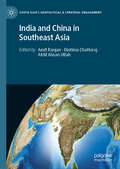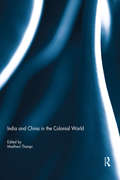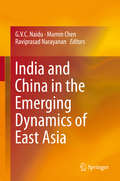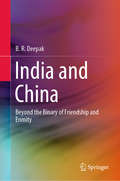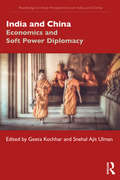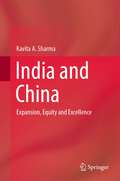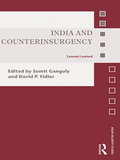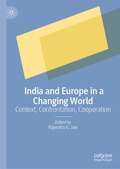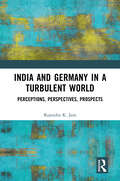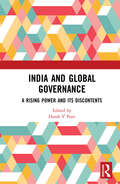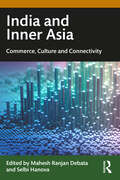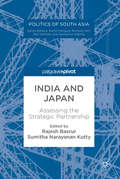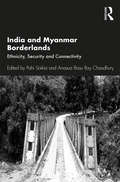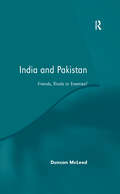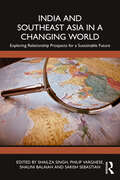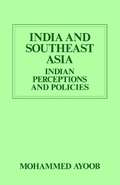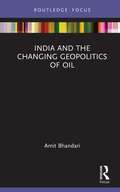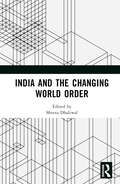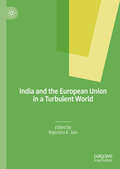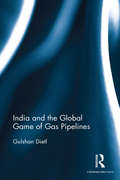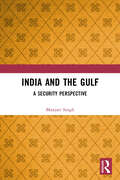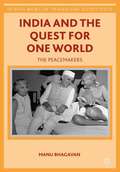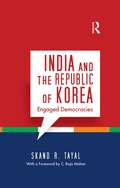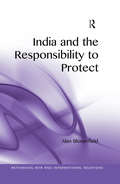- Table View
- List View
India and China in Southeast Asia (South Asia’s Geopolitical & Strategic Engagement)
by Akm Ahsan Ullah Amit Ranjan Diotima ChattorajThis book focuses on the increasing contest and limited cooperation between India and China in Southeast Asia, which is beyond their shared border. This sort of engagement shows how their bilateral tensions are also playing out in the extraterritorial region where the two countries are involved because of history, economics, and security reasons. Chapters in this book look at the various facets of their engagements in the Southeast Asia. It contains both thematic and bilateral issues. Some of the chapters such as on infrastructure, defence etc takes stock of India-China engagements in Southeast Asia, while others mainly deal with how the two Asian powers interact with the individual countries of the region. The readers will benefit from this comprehensive volume in following ways: (a) They will come to know how and why Southeast Asia is an important region for India and China; (b) They will get an idea of how India and China are trying to engage with the Southeast Asia as a regionand at the bilateral level; (c) The readers will understand the role of the Diasporas in linking their respective country of origin with the States they live in ; and ( d) the readers will get aware of how the Asian powers are contesting against each other in the Southeast Asia region for their benefits
India and China in the Colonial World (Berghahn Ser.)
by Madhavi ThampiIndia and China in the Colonial World brings together thirteen essays by eminent Indian and Chinese scholars as well as young researchers who look at the multidimensional interaction between the two countries. This interaction was of many kinds and took place at various levels. This volume casts new light on some of the problems that have confronted the relations between India and China as new states and, in doing so, challenges stereotyped images of this relationship. The major areas of India-China relationships covered in this book include some aspects of the situation during and after World War II. Some papers, such as those on the importance of Shanghai in Sino-Indian trade, the presence of the Chinese community in India and Indians in China; Indian fighters in the Taiping Rebellion; Gandhi and the Chinese in South Africa; and ties between south-west China and north-east India during World War II; present the findings of new research. Others such as those pertaining to India-China relations in the period, such as the opium trade; the controversial visit of Rabindranath Tagore to China; and the complexity of Subhash Chandra Bose’s position with relation to both China and Japan have been put in a new light. The essays in this book are particularly relevant as they help to understand the relationship between India and China in the context of a historical perspective.
India and China in the Emerging Dynamics of East Asia
by G. V. C. Naidu Mumin Chen Raviprasad NarayananThough considerable research literature is now available on China-India relations, most of it still follows a conventional narrative, viewing the relationship through the narrow conflictual prism limited to South Asia than in the new, larger perspective, especially in the context of emerging East Asian dynamics. This book offers comprehensive analyses of some of these issues in papers addressing two broad themes. One, significant trends in the relationship between China and India on a range of issues, including economic development models, their military strategies, and the boundary dispute; and two, how others are responding to the rise of India and China and their impact on East Asia. Together, the chapters constitute a comprehensive study on both China-India relations and their concurrent rise, including a variety of perspectives and methodologies. Written by some of the top experts on the subject from India, China, Japan, and Taiwan and covering a broad range of issues, the book will generate considerable interest in understanding this relatively neglected dimension of today's East Asia.
India and China: Beyond the Binary of Friendship and Enmity (G - Reference, Information And Interdisciplinary Subjects Ser.)
by B. R. DeepakThis book examines the changing dynamics of the issues between India and China in the wake of extensive globalisation, economic slowdown, the trade wars, Covid 19, Galwan and the undercurrents in the emerging new global order. Providing a comprehensive overview of India–China relationship and the role of the USA in the context of India’s economic and security cooperation in the region, it argues that India–China relations are too complex to be defined through the binary of friendship and enmity, since it includes an element of cooperation, competition, coordination and as well as conflict and confrontation. The book also opens new avenues for research. As such it is of interest to researchers and students of Asian studies, Asian history, China studies, peace and conflict studies and international relations.
India and China: Economics and Soft Power Diplomacy (Routledge Critical Perspectives on India and China)
by Geeta Kochhar Snehal Ajit UlmanThis book looks at the changing dynamics of diplomacy of the two emerging global powers – India and China. It examines trade relations, cultural ties and economic engagements of both countries and their shifting influence in the region surrounding them. This volume takes an in-depth look at the trade and economic strategies of India and China through the prism of soft power diplomacy. It reflects on the challenges the two countries face over bilateral trade negotiations, BRICS and China’s Silk Road project, along with other issues of foreign policy. The book underlines the decisive role of the soft power approach and greater people-to-people contact in the global strategies of India and China and in fostering greater cooperation in the region. The book will be of great interest to researchers and students of international relations, political science, public policy and international communications. It will also be useful for think tanks, policy makers and general readers who are interested in the India-China relationship and the politics of soft power diplomacy.
India and China: Expansion, Equity and Excellence
by Kavita A. SharmaThis book provides a comprehensive overview of higher education in India and China and the complexity of issues involved. It focuses on gaining understanding of education systems, governance mechanisms, globalisation and emergence of the private sector, action policies of both the countries and their impact on education and society. Offering a comparative perspective, the book discusses why China is ahead of India in Higher Education when both share the similar challenges of burgeoning young population and scarcity of resources. It examines the success in providing equitable access to both country’s marginalised sections. It also discusses the directions of future growth through National Education Policy, 2020 and the 13th Five Year Plan of the Chinese State Council. Combining rich content and a broad scope, the book offers a valuable key to understanding Higher Education system of India and China. It is a useful read for students and researchers in social sciences, education area.
India and Counterinsurgency: Lessons Learned (Asian Security Studies)
by Sumit Ganguly David P. FidlerThis edited volume focuses on India's experiences waging counterinsurgency campaigns since its independence in 1947. Filling a clear gap in the literature, the book traces and assess the origins, evolution and current state of India's counterinsurgency strategies and capabilities, focusing on key counterinsurgency campaigns waged by India within and outside its territory. It also analyzes the development of Indian doctrine on counterinsurgency, and locates this within the overall ebb and flow of India's defense and security policies. The central argument is that counterinsurgency has been an integral part of India's overall security policy and can thereby impart much to political and military leaders in other states. Since its emergence from British colonialism, India's defence policies have not merely sought to protect and preserve India's inherited colonial borders from threats by rival states, but have also sought to prevent and suppress secessionist movements. In countering insurgencies, the Indian state has fashioned strategies that seek to repress militarily any secessionist movement, while simultaneously forging a range of civilian administrative and institutional arrangements that attempt to address the grievances of disaffected populations. The book highlights key strategic and tactical innovations that the Indian Army and security forces made to deal with a range of insurgent movements. Simultaneously, it also examines how the civilian-military nexus enabled India's policy makers to utilize existing, and formulate novel, institutional means to address extant political grievances. India has been most successful where it has managed to use calibrated force, obtained the trust of much of the aggrieved population and made persuasive commitments to political and institutional reform. Examination of these elements of India's counterinsurgency performance can be compared to counterinsurgency doctrine developed by other countries, including the United States, and thus yield comparative policy prescriptions and recommendations that can be applied to other counterinsurgency contexts. This book will be of great interest to students of counterinsurgency and irregular warfare, Indian politics, Asian Security Studies and Strategic Studies in general.
India and Europe in a Changing World: Context, Confrontation, Cooperation
by Rajendra K. JainThis book explores India’s economic and political relations and defence cooperation with major West European countries—France, Germany, Italy, Spain and the United Kingdom as well as Austria, the Visegrad Four, the Netherlands, Portugal, Sweden and the Baltics. It examines the complexity, the elements of convergence and divergence as well as the challenges and prospects of India’s relations with these countries and assesses the diverging EU think tanks’ images of India. It focuses on India’s multi-dimensional relationship with European countries, which are major trading partners, a significant source and destination of foreign direct investment, an important source of technology and best practices. It examines the Narendra Modi government’s policies to re-energise the India-EU matrix and proactively engage Europe and its sub-regions.
India and Germany in a Turbulent World: Perceptions, Perspectives, Prospects
by Rajendra K. JainIndia shares a multi-dimensional relationship with the Federal Republic of Germany. Germany is India's largest trading partner within the European Union, and is also a major source and destination of foreign direct investment, a significant donor, and an important source of technology.Drawing on English and German language source material, this book covers the evolution and expansion of India’s economic, political, defence, and scientific-technological ties with Germany from 1947 to the present day. It analyses mutual perceptions, highlights the elements of convergence and divergence, and discusses the challenges and prospects of this relationship in a world marked by geopolitical uncertainty.Print edition not for sale in South Asia (India, Sri Lanka, Nepal, Bangladesh, Pakistan and Bhutan)
India and Global Governance: A Rising Power and Its Discontents
by Harsh V PantThis volume explores India’s role in the global governance architecture post–Cold War. It shows how, with a rise in India’s capabilities, there is an expectation from its external interlocutors that New Delhi ought to play a larger global role. As Indian policymakers redefine their engagements in the global policy matrix, the chapters in the volume analyse India’s role as a challenger and a stakeholder in world politics; its uneasy relationship with Western liberal democracies; and its role in shaping new structures of global governance. The volume focuses on a host of critical issues, including nuclear policy, climate action politics, India’s bid for a permanent seat at the UN Security Council, humanitarian interventions, trade governance, democracy promotion, India’s engagement with other emerging powers in platforms such as the BRICS, the changing dynamics with its neighbours, and maritime governance. A timely reimagining of global politics, this book will be of great interest to scholars and researchers of politics and international relations, climate change, military and strategic studies, economics, and South Asian studies.
India and Inner Asia: Commerce, Culture and Connectivity
by Mahesh Ranjan Debata Selbi HanovaThis book studies India’s historical, socio-cultural, and trade linkages with Inner Asia. Inner Asia includes the landlocked regions within East Asia and North Asia that are part of today's Western China, Mongolia, the Russian Far East, and Siberia. The volume examines issues of geopolitics, geoeconomics, climate change, regional cooperation, and discusses the importance of the fabled Silk Road for the countries of Inner Asia. It also analyses the impact India has wielded upon the region through its cultural traits and how Buddhism has remained a binding force between the people of the two regions. Lucid and topical, this book will be of useful for scholars and researchers of Asian studies, central Asian studies, area studies, geopolitics, international trade, international relations, defence and strategic studies, diplomacy and foreign policy, and political studies. It will also be of interest to policymakers, bureaucrats, diplomats and think tanks.
India and Japan: Assessing The Strategic Partnership (Politics Of South Asia Ser.)
by Rajesh Basrur Sumitha Narayanan KuttyThis volume focuses on the rapidly expanding strategic relationship between India and Japan, expanding on the hitherto under-analyzed concept of “strategic partnership,” tracing the history of the interaction, and gauging its current and future trajectories. The rise of China and its challenge to U.S. dominance of the global system is the setting in which the partnership has assumed a major profile, incorporating both defence and economic cooperation on an unprecedented scale. The increasing congruence of Indian and Japanese interests is juxtaposed with the inherent limitations of the partnership to portray a complex picture of a kind of strategic relationship that has become a staple of contemporary international politics.
India and Myanmar Borderlands: Ethnicity, Security and Connectivity
by Pahi Saikia Anasua Basu Ray ChaudhuryThis book explores the India–Myanmar relationship in terms of ethnicity, security and connectivity. With the process of democratic transition in Myanmar since 2011 and the ongoing Rohingya crisis, issues related to cross-border insurgency are one of the most important factors that determine bilateral ties between the two neighboring countries. The volume discusses a diverse range of themes – historical dimensions of cooperation; contested territories, resistance and violence in India–Myanmar borderlands; ethnic linkages; political economy of India–Myanmar cooperation; and Act East Policy – to examine the prospects and challenges of the strategic partnership between India and Myanmar, and analyzes further possibilities to move forward. The chapters further look at cross-border informal commercial exchanges, public health, population movements, and problems of connectivity and infrastructure projects. Comprehensive, topical and with its rich empirical data, the volume will be useful to scholars and researchers of political studies, international relations, security studies, foreign policy, contemporary history, and South Asian studies as well as government bodies and think tanks.
India and Pakistan: Friends, Rivals or Enemies?
by Duncan McLeodAre India and Pakistan rivals or enemies? Despite a voluminous output of political and, in particular, historical accounts of this extraordinary and unique relationship in international politics, there has been little attempt to theorize the culture of violence between these two states. As a consequence, the study of India-Pakistan relations suffers from what the author labels historical reiteration - that is, the dispute is historicized in a way that reproduces the preconceived division of 1947. Duncan McLeod moves the debate away from historical reiteration to instead theorize on the levels, nature and culture of violence between India and Pakistan since partition and independence in 1947. He examines the politicization of culture, cultures of rivalry and conflict, enmity and unlimited conflict. The volume will appeal to students and scholars in the fields of political theory, Asian politics and political sociology.
India and Southeast Asia in a Changing World: Exploring Relationship Prospects for a Sustainable Future
by Shailza Singh Philip Varghese Shalini Balaiah Sarish SebastianThis book presents a comprehensive analysis of India’s relationship with the Southeast Asian nations in the context of the changing dynamics of international relations and the emergence of Indo-Pacific as the theatre of world politics. It covers a wide range of themes, from strategic to political, economic, diplomatic and security aspects, and assesses how India’s redefining of its role in world politics unfolds through its posture towards the Southeast Asian region.The volume will be of great interest to scholars and researchers of Asian studies, both South Asian and Southeast Asian studies, and politics and international relations. It will also be useful for public policy analysts and think tanks and policymakers.
India and Southeast Asia: Indian Perceptions and Policies (Routledge Revivals)
by Mohammed AyoobThis title, first published in 1990, provides a close contextual analysis of how influential Indian policy-makers have perceived India's interests within the ASEAN region since Indian independence in 1947. Placing these perceptions in the context of India's broad strategic and foreign policy framework, Ayoob analyses the policies which had emerged by the close of the 1980s and stresses the close link between the futures of the two regions. Including a thorough analysis of superpower involvement, as well as Indian relations with Indonesia, Vietnam and Cambodia, this is a comprehensive study of great value to students with an interest in Indian and Southeast Asian history and diplomacy.
India and the Changing Geopolitics of Oil (The Gateway House Guide to India in the 2020s)
by Amit BhandariThe global energy scenario has transformed in the past 20 years. Oil demand, earlier driven by the West, is now shifting to the East, more specifically to Asia. New oil supplies from North America have challenged the hegemony of the traditional oil exporters from West Asia and Africa. India, once a marginal player in the world oil market, is now a valued customer providing demand security for oil exporters. This book systematically examines India’s oil and gas trade, which makes it the world’s third largest importer of oil after China and the US. It explores the changing patterns of oil demand and supply, and the growing market for natural gas, renewable energy, biofuel, and alternative sources of energy. Further, the volume discusses a range of issues that affect India’s position in the global energy econom,y such as The geographic shifts in energy production and trade; international relations and economic sanctions that affect the oil trade; India’s quest for energy security; and contest with China for oil assets; Building new partnerships, and investing in stable, oil-rich countries like the US and Canada, while keeping up existing energy relations with Saudi Arabia, the UAE and Kuwait; Using market mechanisms to ensure energy security. Topical and comprehensive, this book in The Gateway House Guide to India in the 2020s series will be useful for scholars and researchers of international relations, geopolitics, foreign policy, security and strategic studies, energy studies, West Asia studies, South Asian studies, and international trade. It will also be of interest to policymakers, diplomats, career bureaucrats, and professionals working with think tanks, academia and multilateral agencies, media agencies, and businesses.
India and the Changing World Order
by Shveta DhaliwalThis book brings together new perspectives on India’s foreign policy in the light of a constantly shifting world order. From India’s relations in its immediate neighborhood to its China policy, from India-US relations under Biden to Quad, from Grand Strategy to peacekeeping, this book brings to the fore the shifting terrains of global politics and India’s significant place in it. The chapters in the volume: Critically examine changing preoccupations of India’s foreign policy and its geopolitical interests, including its Act East Policy; Include comprehensive inputs on India’s China policy and relations with Japan; Explore India’s relations with the USA, the Middle-East, Afghanistan, and Central Asia; Discuss at length India’s nuclear, energy, and foreign investment policies; Analyze India’s positioning on the emergence of the Indo-Pacific discourse. This volume will be of great interest to scholars and researchers of political science and international relations. It will also be of use to foreign policy and diplomacy practitioners, career bureaucrats and government think tanks.
India and the European Union in a Turbulent World
by Rajendra K. JainThe book examines how the European Union, which in the past had tended to be seen by India as an undervalued partner, is now increasingly part of most conversations in fields like the economy, technology, standards, best practices, development, defence and security.The book shows that the renewed focus on Europe is the result of changing geopolitics, India’s own priorities, Europe’s growing relevance in the post-Brexit era, China’s expanding footprint in the continent, and the search for alternatives to the loss of the UK as the gateway to Europe. The uncertainty inherent in the Brexit process and with the UK ceasing/having ceased to be the traditional gateway to Europe, India has been compelled to revisit, re-examine and rethink its own policies towards Europe and search for alternatives to Britain.
India and the Global Game of Gas Pipelines
by Gulshan DietlGas pipelines constitute an important, yet unexplored, aspect of strategic geography. As one of the fastest growing economies in the world, India’s need for energy is paramount. Though surrounded by gas-rich regions – Myanmar and Bangladesh to the east, the Gulf to the west and Central Asia to the north – India does not have a single gas pipeline coming in, going out or traversing through its territory to date. This book highlights the global competition over gas pipelines and its implications for India’s energy security in a comprehensive manner. The author leads us through a labyrinthine world comprising numerous actors – the states, energy firms, scientists, engineers, investors and bankers – engaged in competition over these pipelines leading to a continuous game of checkmating rivals, instigating conflicts, causing damage and destruction and threatening military action to persuade or dissuade states from joining specific projects. Pulsating, rigorous, grounded in hard facts and solid research, this book will be indispensable for scholars and researchers of international relations, strategic affairs, defence studies and politics, as well as think tanks, government agencies and the informed general reader.
India and the Gulf: A Security Perspective
by Manjari SinghIndia’s relations with the Persian Gulf countries are often viewed from a narrow prism of energy, economy, and expatriates. However, since the beginning of the 21st century, with New Delhi’s Neo-West Asia policy, the region has gained more interest in the strategic communities.Emphasizing on the various aspects of security paradigm, this book covers both conventional and unconventional aspects of New Delhi’s overall security architecture with the Gulf region. It discusses the security dynamics that characterise the relationship between India and the Gulf nations. The subject matter in this book facilitates a holistic understanding of security paradigm in Indo-Gulf relations and provides a nuanced examination of the multifaceted aspects of security cooperation, challenges, and opportunities in this crucial geopolitical space.Print edition not for sale in South Asia (India, Sri Lanka, Nepal, Bangladesh, Pakistan and Bhutan)
India and the Islamic Heartlands
by Sood Gagan D. S."Based on the chance survival of a remarkable cache of documents, India and the Islamic Heartlands recaptures a vanished and forgotten world from the eighteenth century spanning much of today's Middle East and South Asia. Gagan Sood focuses on ordinary people--traders, pilgrims, bankers, clerics, brokers, scribes, among others--who were engaged in activities marked by large distances and long silences. By elucidating their everyday lives in a range of settings, from the family household to the polity at large, Sood pieces together the connective tissue of a world that lay beyond the sovereign purview. Recapturing this obscured and neglected world helps us better understand the region during a pivotal moment in its history, and offers new answers to old questions concerning early modern Eurasia and its transition to colonialism"--
India and the Quest for One World
by Manu BhagavanIndia and the Quest for One World revolutionizes the history of human rights, with dramatic impact on some of the most contentious debates of our time, by capturing the exceptional efforts of Mahatma Gandhi and the Nehrus to counter the divisions of the Cold War with an uplifting new vision of justice built on the principle of "unity in diversity. "
India and the Republic of Korea: Engaged Democracies
by Skand R. TayalExamining the underlying logic of the strategic and economic partnership between the Republic of Korea and India, this book is the first detailed study of the numerous facets — cultural, economic, people-to-people, and strategic — of blossoming relations between two major Asian democracies. This comprehensive survey documents the interaction between the two governments, relying on facts and hitherto unpublished original records provided by India’s Ministry of External Affairs; offers an illuminating account of India’s active role as a neutral party in the post-Second World War events of the Korean War and the division of the Korean Peninsula; and provides a vision of the future direction of India–Korea relations. The author also shares candid observations of Korean society and its people during his service as Ambassador of India in Seoul. The work will be useful to policy makers as well as students of politics and international relations, strategic studies, economics, and contemporary world history.
India and the Responsibility to Protect: Negotiating Democratic Postcolonial And Great Power Identities (Rethinking Asia and International Relations)
by Alan BloomfieldBloomfield charts India’s profoundly ambiguous engagement with the thorny problem of protecting vulnerable persons from atrocities without fatally undermining the sovereign state system, a matter which is now substantially shaped by debates about the responsibility to protect (R2P) norm. Books about India’s evolving role in world affairs and about R2P have proliferated recently, but this is the first to draw these two debates together. It examines India’s historical responses to humanitarian crises, starting with the 1971 Bangladesh Liberation War, concentrating on the years 2011 and 2012 when India sat on the UN Security Council. Three serious humanitarian crises broke during its tenure - in Côte d'Ivoire, Libya and Syria - which collectively sparked a ferocious debate within India. The book examines what became largely a battle over ’what sort of actor’ modern India is, or should be, to determine how this contest shaped both India’s responses to these humanitarian tragedies and also the wider debates about rising India’s international identity. The book’s findings also have important (and largely negative) implications for the broader effort to make R2P a recognised and actionable international norm.
